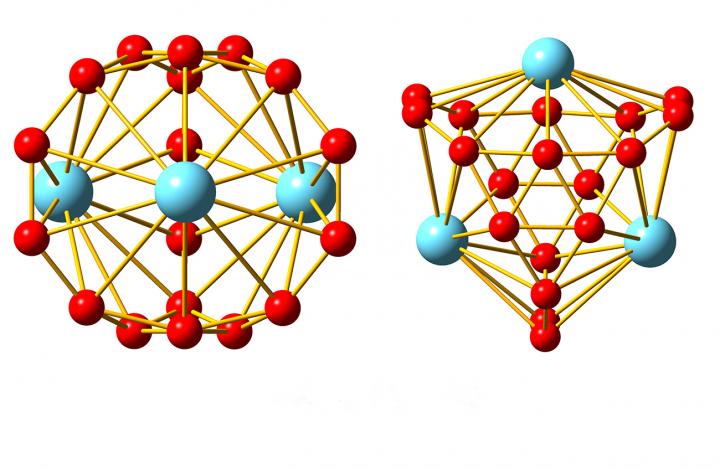Researchers discover new boron-lanthanide nanostructure

The family of boron-based nanostructures has a new member: metallo-borospherenes, hollow cages made from 18 boron atoms and three atoms of lanthanide elements. Credit: Wang Lab / Brown University
Now, researchers from Brown and Tsinghua University have added another boron nanostructure to the list. In a paper published in Nature Communications, they show that clusters of 18 boron atoms and three atoms of lanthanide elements form a bizarre cage-like structure unlike anything they've ever seen.
“This is just not a type of structure you expect to see in chemistry,” said Lai-Sheng Wang, a professor of chemistry at Brown and the study's senior author. “When we wrote the paper we really struggled to describe it. It's basically a spherical trihedron. Normally you can't have a closed three-dimensional structure with only three sides, but since it's spherical, it works.”
The researchers are hopeful that the nanostructure may shed light on the bulk structure and chemical bonding behavior of boron lanthanides, an important class of materials widely used in electronics and other applications. The nanostructure by itself may have interesting properties as well, the researchers say.
“Lanthanide elements are important magnetic materials, each with very different magnetic moments,” Wang said. “We think any of the lanthanides will make this structure, so they could have very interesting magnetic properties.”
Wang and his students created the lanthanide-boron clusters by focusing a powerful laser onto a solid target made of a mixture of boron and a lanthanide element. The clusters are formed upon cooling of the vaporized atoms.
Then they used a technique called photoelectron spectroscopy to study the electronic properties of the clusters. The technique involves zapping clusters of atoms with another high-powered laser. Each zap knocks an electron out of the cluster.
By measuring the kinetic energies of those freed electrons, researchers can create a spectrum of binding energies for the electrons that bond the cluster together.
“When we see a simple, beautiful spectrum, we know there's a beautiful structure behind it,” Wang said.
To figure out what that structure looks like, Wang compared the photoelectron spectra with theoretical calculations done by Professor Jun Li and his students from Tsinghua. Once they find a theoretical structure with a binding spectrum that matches the experiment, they know they've found the right structure.
“This structure was something we never would have predicted,” Wang said. “That's the value of combining theoretical calculation with experimental data.”
Wang and his colleagues have dubbed the new structures metallo-borospherenes, and they're hopeful that further research will reveal their properties.
###
Other co-authors on the paper were Teng-Teng Chen, Wan-Lu Li, Wei-Jia Chen, Xiao-Hu Yu, Xin-Ran Dong. The research was supported by National Science Foundation (CHE-1763380) and National Natural Science Foundation of China (21590792, 91426302 and 21433005).
Media Contact
All latest news from the category: Materials Sciences
Materials management deals with the research, development, manufacturing and processing of raw and industrial materials. Key aspects here are biological and medical issues, which play an increasingly important role in this field.
innovations-report offers in-depth articles related to the development and application of materials and the structure and properties of new materials.
Newest articles

Pinpointing hydrogen isotopes in titanium hydride nanofilms
Although it is the smallest and lightest atom, hydrogen can have a big impact by infiltrating other materials and affecting their properties, such as superconductivity and metal-insulator-transitions. Now, researchers from…

A new way of entangling light and sound
For a wide variety of emerging quantum technologies, such as secure quantum communications and quantum computing, quantum entanglement is a prerequisite. Scientists at the Max-Planck-Institute for the Science of Light…

Telescope for NASA’s Roman Mission complete, delivered to Goddard
NASA’s Nancy Grace Roman Space Telescope is one giant step closer to unlocking the mysteries of the universe. The mission has now received its final major delivery: the Optical Telescope…


